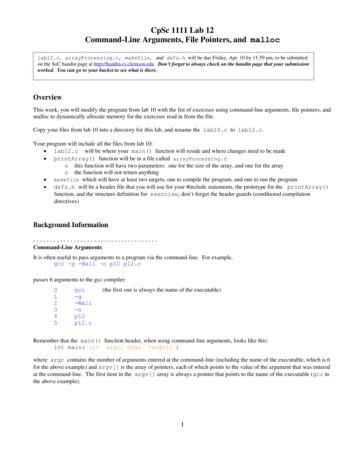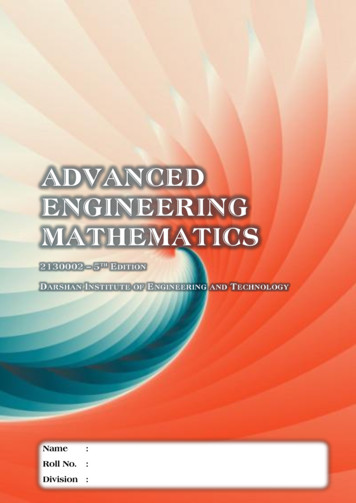F2FS: A New File System Designed For Flash Storage In Mobile
F2FS: A New File System Designed forFlash Storage in MobilePresented at ELC Europe 2012Nov 05, 2012Joo-Young HwangS/W Development TeamMemory Business, Samsung Electronics Co., Ltd.
Agenda IntroductionDesign OverviewPerformance Evaluation ResultsSummary
Introduction NAND Flash-based Storage Devices– SSD for PC and server systems– eMMC for mobile systems– SD card for consumer electronics The Rise of SSDs– Much faster than HDDs– Low power consumptionSource: March 30th, 2012 by Avram Piltch, LAPTOP Online Editorial Director
Introduction (cont’d) File System– Serve directory and file operations to users– Manage the whole storage ile)ApplicationsOSread(file, offset)write(file, offset)Directory structureMemory ManagementFile structureIndex structureMemory managementFile SystemSpace managementPower-Off e“file”inodedata
Introduction (cont’d) NAND Flash Memory– Erase-before-write– Sequential writes inside the erase unit– Limited program/erase (P/E) cycle Flash Translation Layer (FTL)––––Conventional block device interface: no concern about erase-before-writeGarbage collectionWear-levelingBad block management Issues in cheap FTL devices– Random write performance– Life span and reliability Conventional file systems for FTL devices?– Optimization for HDD performance characteristics may not be good for FTL.– No consideration for FTL device characteristics
LFS Approach Sequential write is preferred by FTL devices. Log-structured File System (LFS)[1] fits well to FTL devices.– Assume the whole disk space as a big log, write data and metadata sequentially– Copy-on-write: recovery support is made easy.[LFS][non LFS]LogicalBlockAddress48Metadata Area8765437621User Data Area5321Metadata AreaUser-data Area Metadata AreaTime[1] Mendel Rosenblum and John K. Ousterhout. 1992. The design and implementationof a log-structured file system. ACM Trans. Comput. Syst. 10, 1Time(February 1992), 26-52.
Conventional Log-structured File System (Index Structure)Fixed location, but separatedSBOne big logCP Wandering tree problem Performance drop at high utilizationdue to cleaning cost.InodeMapDir InodeDirectory dataFile InodeFile dataSegmentUsageSegmentSummaryUsed for cleaningIndirectPointer block DirectPointer blockFile data
F2FS Design Overview Alignment with FTL operation unit– Align FS data structures to the FTL operation units. Avoiding Metadata Update Propagation– Indirection for inode and pointer blocks Efficient Cleaning using Multi-head Logs and Hot/Cold Data Separation– Write-time data separation more chances to get binomial distribution– Two different victim selection policies for foreground and background cleaning– Automatic background cleaning Adaptive Write Policy for High Utilization– Switches write policy to threaded logging at right time (logging to FTL overprovision space)– Graceful performance degradation at high utilization
FTL Device Characteristics FTL Functions– Address Mapping– Garbage Collection Address Mapping Methods– Block Mapping– Page Mapping– Hybrid Mapping
Hybrid Mapping Hybrid Mappings– BAST– FAST– SAST (N: N K mapping)Log block group #1Log block group #2Log BlockLog BlockLog BlockLog lockDataBlockDataBlockBlockData block group #1 Merge in Hybrid Mapping– Performed to get a new log block– Merge typesData block group #2[Example - 4:4 2 mapping ]Log Block– Full merge– Partial merge (aka copy merge)– Switch lockBlock
FTL Device Characteristics (cont’d) FTL operation unit– Superblock – simultaneously erasable unit– Superpage - simultaneously programmable unit Implications for segment size
FTL Device Characteristics (cont’d) FTL device may have multiple logging streams without performancedegradation.– How many streams? How to identify?– Data block group geometry? Implications for multi-headed logging
FTL Awareness All the FS metadata are located together for locality Start address of main area is aligned to the zone* size Cleaning operation is done in a unit of section**zone: data block group*section: FTL GC unitRandom writesSequential writesZoneSectionSegment Number(1 segment Section Main AreaSuperblock 0Superblock 1SectionZoneCheckpointAreaSegmentInfo.Table(SIT)2 segmentsPer 2044GBof main areaNodeAddressTable(NAT)0.4% overmain areaSegmentSummaryArea(SSA)0.2% overmain areaHot/Warm/Coldnode segmentsHot/Warm/Colddata segments
Avoiding Metadata Update PropagationFixed location w/ localitySBCPMultiple logsNATTranslated by NATDir InodeDirectory dataFile InodeFile dataSegment Info.Table ect node blocks for dir-Direct node blocks for file-Indirect node blocks-Dir data-File data-Cleaning data File data
File IndexingDirect [929]Indirect [2]Double [2]Triple [1]928929194619472964296539822075613About 3.94 TBFor 4KB block
Cleaning Cleaning Process––––Reclaim obsolete data scattered across the whole storage for new empty log spaceGet victim segments through referencing segment usage tableLoad parent index structures of there-in data identified from segment summary blocksMove valid data by checking their cross-reference Goal– Hide cleaning latencies to users– Reduce the amount of valid data to be moved– Move data quickly Issues– Hot and cold data separation– Victim selection policy
Cleaning (cont’d) Efficient hot/cold separation is possible by exploiting the FTL’s multiple logs. Hot/cold separation at data writing time based on object types– Cf) hot/cold separation at cleaning time requires per-block update frequency information.TypeUpdate frequencyHotNodeContained ObjectsDirectory’s inode block or direct node blockWarmRegular file’s inode block or direct node blockColdHotWarmIndirect node blockDirectory’s data blockUpdated data of regular filesAppended data of regular files,moved data by cleaning,multimedia file’s dataDataCold
Cleaning (cont’d) Automatic Background Cleaning– Kicked in when I/O is idle.– Lazy write: cleaning daemon marks page dirty, then flusher issued I/O later.– Do not intervene foreground jobs. Victim Selection Policies– Greedy algorithm for foreground cleaning– Cost-benefit algorithm for background cleaning
Adaptive Write Policy Normal write policy is logging to a clean segment– Need cleaning operations if there is no clean segment.– Cleaning causes mostly random read and sequential writes. Change policy to threaded logging if there are not enough clean segments.– Reuse obsolete blocks in a dirty segment– No need to run cleaning– May cause random writes (in a small range)
Performance (Panda board eMMC)35[ System Specification ]ARM Cortex-A9 1.2GHzDRAM1GBStorageSamsung eMMC 64GBKernelLinux 3.3Bandwidth (MB/s)CPU302520151050Partition Size 12 GBseq. Readseq. Writerand. Readrand. 5.204[ iozone ]12000Files / sec1000080006000400020000[ fs mark 262079625992[ bonnie ]
Performance on Galaxy NexusCPUDRAMStorageKernelAndroid ver.ARM Coretex-A9 1.2GHz1GBSamsung eMMC (VFX) 16GB3.0.8Ice Cream Sandwich Clean Aged ItemsExt4F2FSImprov.ItemsExt4F2FSImprov.Contact sync time(seconds)43135820%Contact sync time(seconds)43737517%App install time(seconds)4594570%App install time(seconds)362370-2%RLBench (seconds)92.678.917%RLBench s)IOZone WithAppInstall(MB/s)
Evaluation: Cleaning Victim Selection Policies Setup––––In x86, set 3.7 GB partitionCreate three files having 1GB dataWrite 256MB data randomly to the three filesWrite 256MB data randomly to one of them, 30 times
Evaluation: Adaptive Write Policy Experimental setup– Embedded system with eMMC 12GB partition– Iozone random write tests on several 1GB files Results– Sustained performance is improved by adaptive write.– Ext4 shows about 4MB/s sustained performance.
Summary Flash-Friendly File System– File system for FTL block devices– Optimized for mobile flash solutions Performance evaluation on Android Phones– /data is F2FS volume– Factory reset & run android apps Current Status– Patch review in progress at LKML: v3 patch series are released.– Code and performance review on various devices are welcome.
Thank you!
Flash-Friendly File System – File system for FTL block devices – Optimized for mobile flash solutions Performance evaluation on Android Phones – /data is F2FS volume – Factory reset & run android apps Current Status – Patch
F2FS: A New File System for Flash Storage Changman Lee, Dongho Sim, Joo-Young Hwang, and Sangyeun Cho S/W Development Team Memory Business Samsung Electronics Co., Ltd. Abstract F2FS is a Linux file system designed to perform well on modern flash storage devices. The file system builds
Flash-Friendly File System – Designed for FTL block devices (not for raw NAND flash) – Optimized for mobile flash storages – Can also work for SSD Performance evaluation on Android Phones – Format /data as an F2FS volume. – Basic
UNIX has single File system. Devices are mounted into this File System. File System Implementation FILE SYSTEM- A Group of files and its relevant information forms File System and is stored on Hard Disk. On a Hard Disk, a Unix File system is stored in terms of blocks where each block is equal to 512 bytes.
The Integrated File System What is a file system? Webopedia.com defines a file system as “The system that an operating system or program uses to organize and keep track of files.” The System i has a number of different file systems QSYS.LIB file system uses libraries as container
A file pointer must be declared and used to access a file. Declaring a file pointer would be in this general form: FILE * ptr_name for example: FILE * inFile; // for an input file FILE * outFile; // for an output file inFile and outFile are just variable names, and as you know, you can name your variables whatever you want.
akuntansi musyarakah (sak no 106) Ayat tentang Musyarakah (Q.S. 39; 29) لًََّز ãَ åِاَ óِ îَخظَْ ó Þَْ ë Þٍجُزَِ ß ا äًَّ àَط لًَّجُرَ íَ åَ îظُِ Ûاَش
Collectively make tawbah to Allāh S so that you may acquire falāḥ [of this world and the Hereafter]. (24:31) The one who repents also becomes the beloved of Allāh S, Âَْ Èِﺑاﻮَّﺘﻟاَّﺐُّ ßُِ çﻪَّٰﻠﻟانَّاِ Verily, Allāh S loves those who are most repenting. (2:22
Divis ADVANCED ENGINEERING MATHEMATICS 2130002 – 5th Edition Darshan Institute of Engineering and Technology Name : Roll No. : ion :























